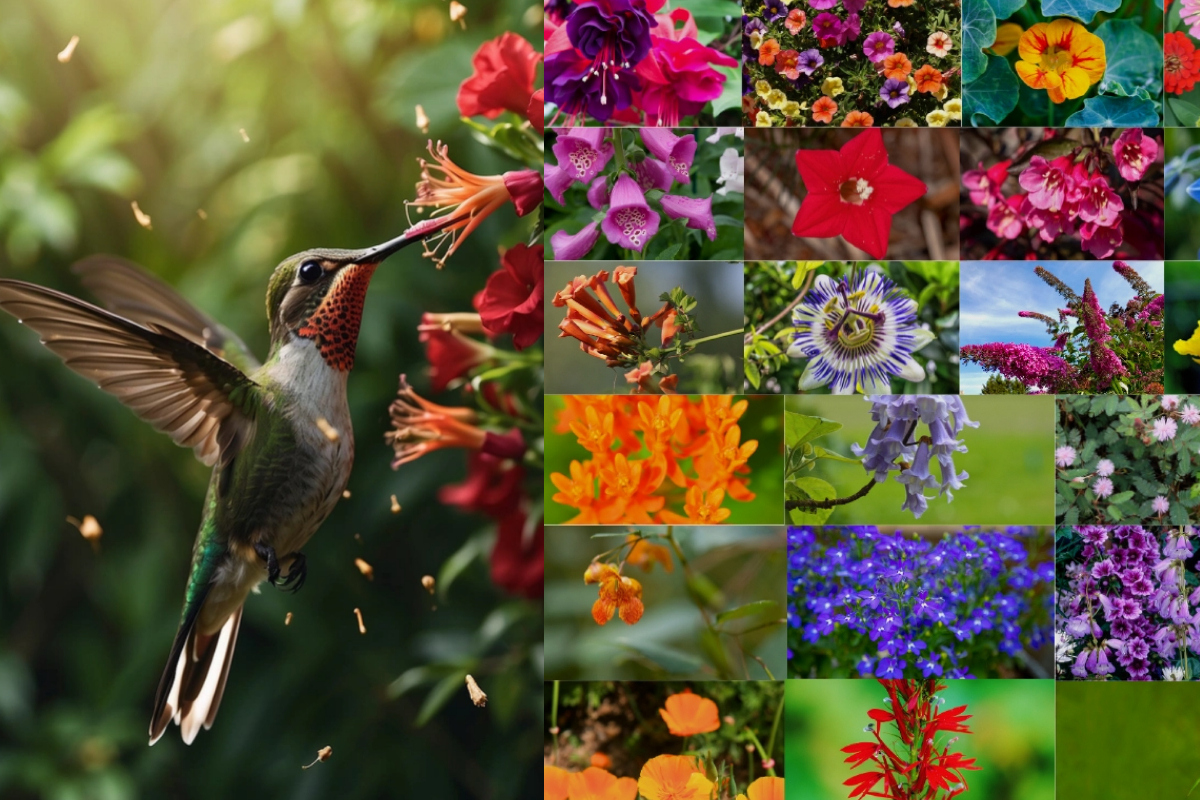Hummingbirds are some of the most fascinating birds to observe. With their Swift flight, jewel-coloured feathers, and ability to hover and fly backwards, they seem almost magical. If you want to attract these tiny dynamos to your yard, planting flowers that appeal to hummingbirds is key. The nectar many blooms produce is high in sugar and gives hummingbirds quick energy.
In this blog post, we will explore 33 top plants that attract hummingbirds. We’ll cover annuals, perennials, shrubs, vines, and trees that hummers find irresistible due to their tubular blooms, bright colours, and sweet nectar. Read on to learn the best plants to add to your landscape if you want to welcome hummingbirds!
Key Takeaways: Plants That Attract Hummingbirds
- Annuals like fuchsia, zinnia, petunia, and nasturtium are great temporary plantings that will attract hummingbirds.
- Perennials such as bee balm, coral bells, cardinal flowers, and columbine provide nectar year after year as they bloom seasonally.
- Tubular red flowers tend to be hummingbird favourites, as they cannot resist bright, scarlet blooms.
- Native plants are ideal for providing the food and habitat hummingbirds rely on. Fit natives like milkweed, trumpet vine, and butterfly weed into your landscape for best results.
Other Related Post To Read: Hummingbird Diet and Nutrition.
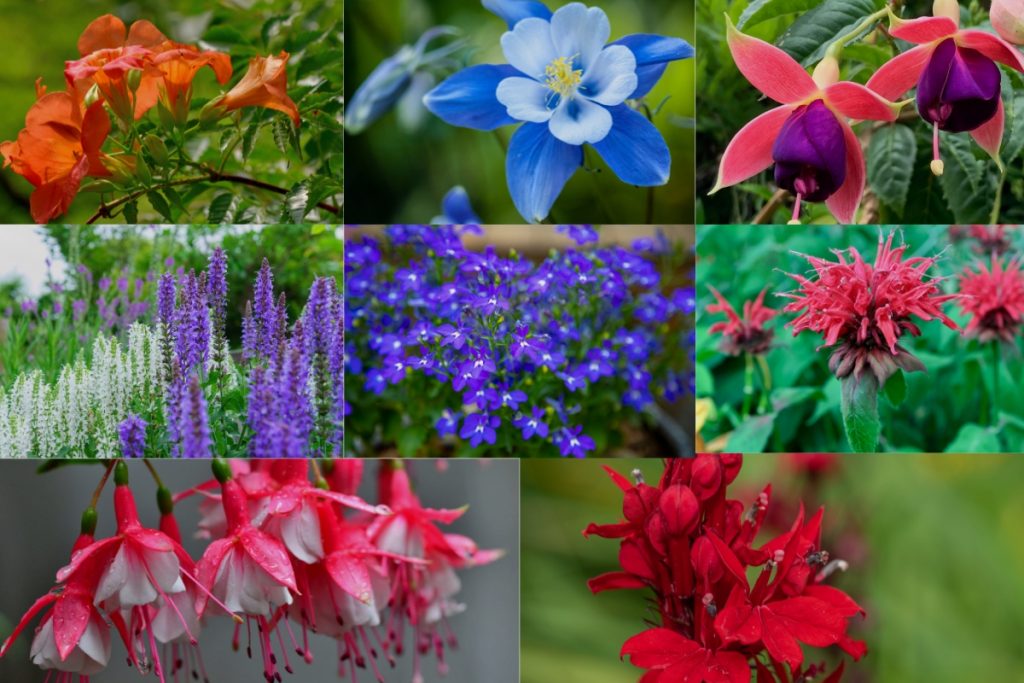
What Makes a Good Hummingbird Plant
Hummingbirds are attracted to several key characteristics when seeking out plants:
Brightly Colored Tubular Flowers
Hummingbirds have excellent colour vision and zero in on brilliant reds, oranges, purples, and hot pinks. They use their slender bills to access nectar deep inside tubular flowers. This gives them exclusive access to the high-energy food source while keeping competing insects away.
Trumpet-shaped flowers allow ample room for hummingbirds to dip their long tongue into pools of sweet nectar. The tubes prevent shorter-tongued insects and other animals from stealing the precious liquid.
Some classic hummingbird flowers include:
- Fuchsia
- Cardinal flower
- Trumpet vine
- Salvia
- Bee balm.
Abundant Nectar
Hummingbirds have very high metabolisms. To support their constant motion and hovering in midair, they need to consume over half their body weight in nectar each day.
Flowers that produce ample nectar are crucial to fuel these tiny powerhouses. Especially hot, dry weather can lessen nectar production, so providing a range of flowering plants that bloom at different times prevents seasonal slumps in food availability.
Some top nectar producers include:
- Lobelia
- Fuschia
- Columbine.
Native Plants
Native plants hold special value for hummingbirds and other native pollinators. They are the wild species that have formed tight ecological relationships with animals, insects, and birds over eons of adaptation.
As natives like columbine, trumpet vine, and cardinal flower have evolved alongside hummingbirds for centuries, they supply the specific food these birds rely on. Their flowering schedules align with hummingbird migration and nesting seasons, too. Supporting native plants fosters sustainable hummingbird populations.
Range of Flowering Times
Hummingbirds start arriving from their southern winter homes as early as January in warm southern states. Some travel all the way to Alaska by May to breed. They continue grazing on flowers through fall, depending on the species.
Planting a wide range of annuals, perennials, and shrubs that bloom at different times ensures nectar will be available from spring through fall. Canna lily and bee balm provide midsummer food while autumn-blooming snapdragons and pineapple sage offer late-season nutrition.
33 Must-Have Hummingbird Plants
From vines and shrubs to striking annuals, these plants will make your garden or containers irresistible for hummingbirds.
Annuals
Annuals complete their growing cycle from germination to seed production in a single season. As they only persist for one year, replanting is necessary to provide nectar annually. But annuals allow flexibility to adjust your garden readily for maximum hummingbird appeal.
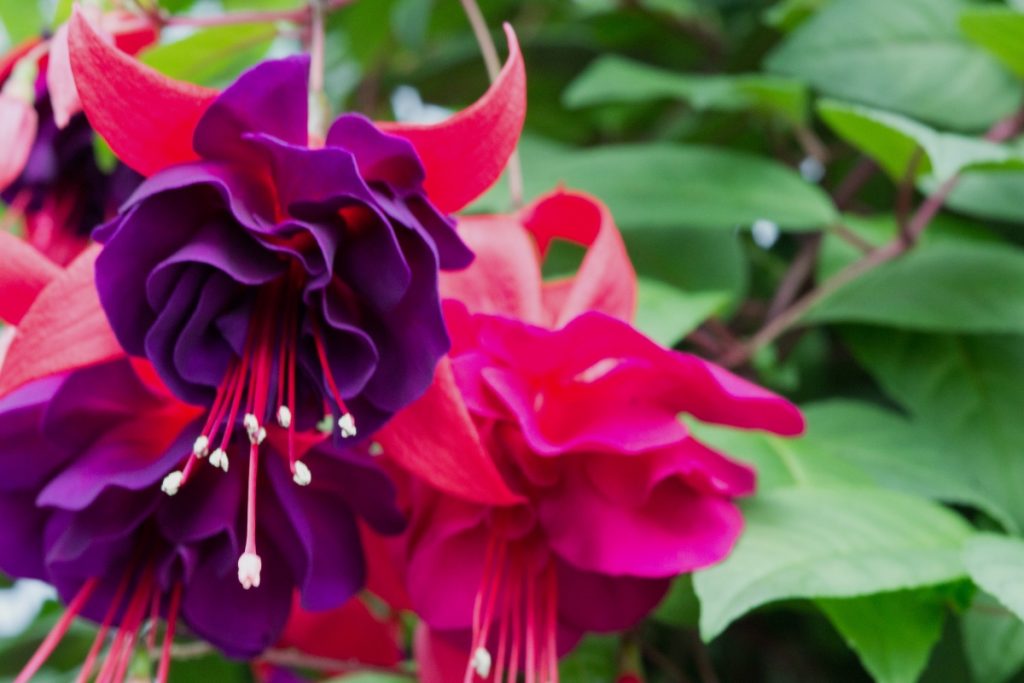
1. Fuchsia
No flower says “hummingbird favourite” like graceful weeping fuchsia. Both trailing and upright varieties produce delicate tubular blossoms in vivid shades like magenta, purple, and red, often with contrasting white interiors. Hummingbirds probe the small flowers tirelessly for the sweet nectar. Give fuchsia morning sun with afternoon shade, especially in hot climates. Grow it in hanging baskets or garden beds for gorgeous summer colour.
Zones: 3-10
Height: 1-4 ft
Flower Color: pink, red, purple, white
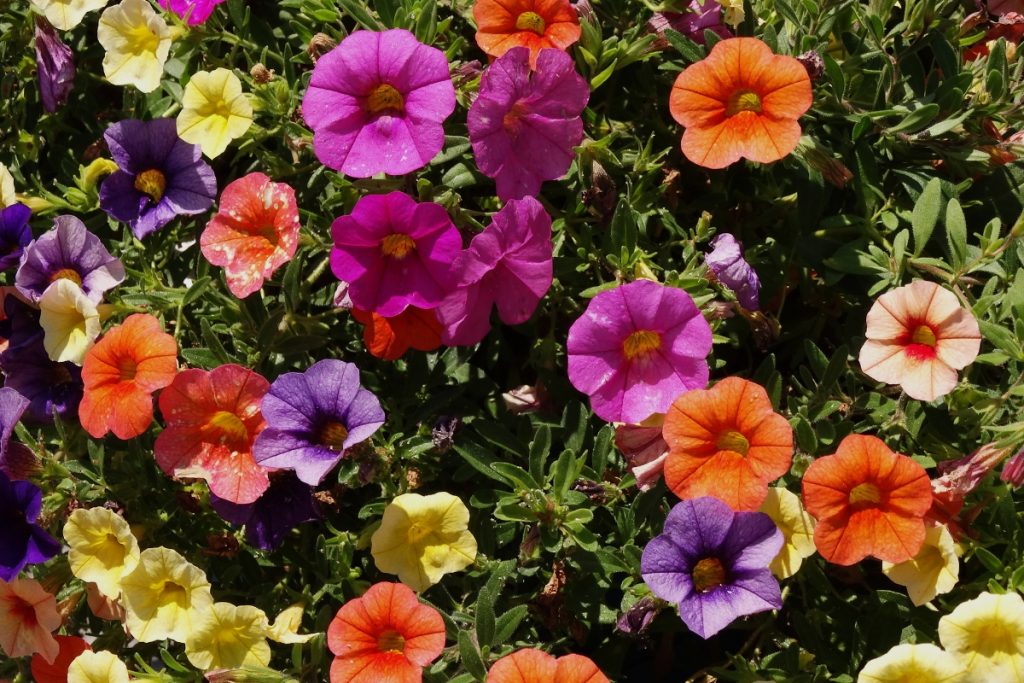
2. Petunia
A summertime classic, petunias come in a huge range of solid and bi-colours that hummingbirds zero in on. Their trumpet shape makes it simple for hummingbirds to access nectar. Easy-care, heat-loving petunias can be grown in beds, containers, and window boxes for vibrant spring-to-frost blooms. Try red varieties like ‘Red Ray’ and ‘Crimson Star’ or purple/blue hybrids, which attract hummingbirds too.
Zones: 9-11
Height: 6-12 inches
Flower Color: all colours.
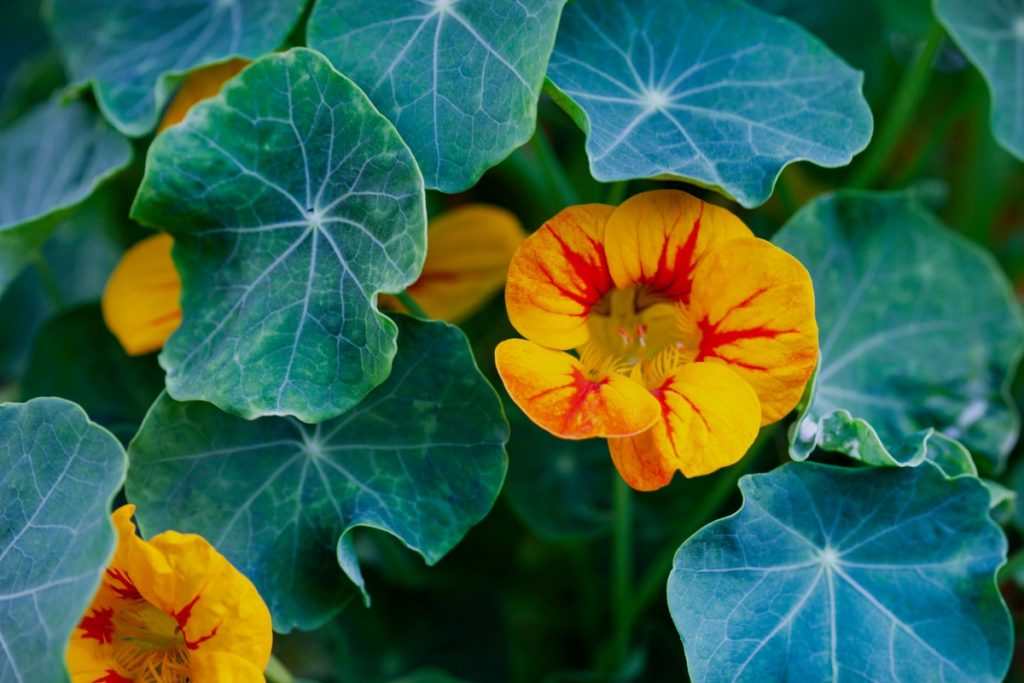
3. Nasturtium
No flower garden would be complete without nasturtiums. These cheery annuals produce abundant blooms in vibrant, warm colours with a sweet, spicy scent. Their shallow, cup-shaped blossoms invite hummingbirds to perch and probe. Plant vining types to trail from containers and baskets. Compact bush varieties thrive in flower beds. Choose single or double-flower types for the most nectar.
Zones: 10-11
Height: 6 inches to 8 ft
Flower Color: yellow, orange, red.
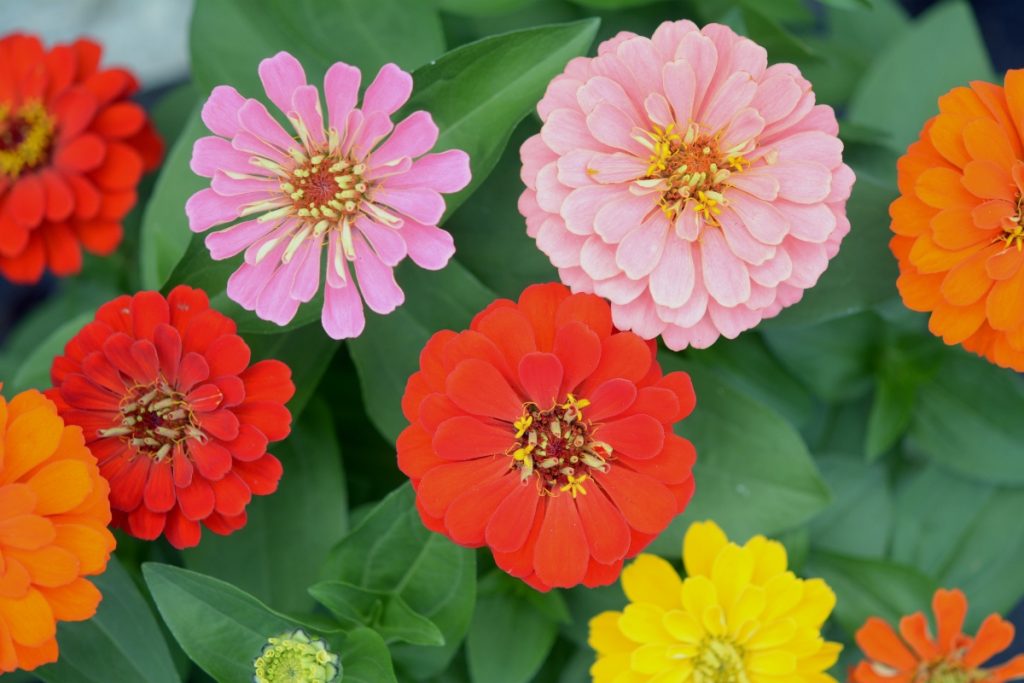
4. Zinnia
Zinnias love heat, drought, and full sun, making them ideal for attracting late-summer hummingbirds. The daisy-like flowers come in infinite colours with single, double, and cactus-flower shapes. Grow dwarf varieties in containers near feeders or plant taller types in borders. ‘Magellan’ zinnias produce abundant large, vivid blooms on disease-resistant, sturdy plants.
Zones: 9-11
Height: 6 inches to 4 ft
Flower Color: all colours.
Perennials
Perennials persist for many years, often thriving for a decade or longer in the right growing conditions. Though slow to establish, they require little yearly maintenance yet provide reliable food and habitat for hummingbirds.
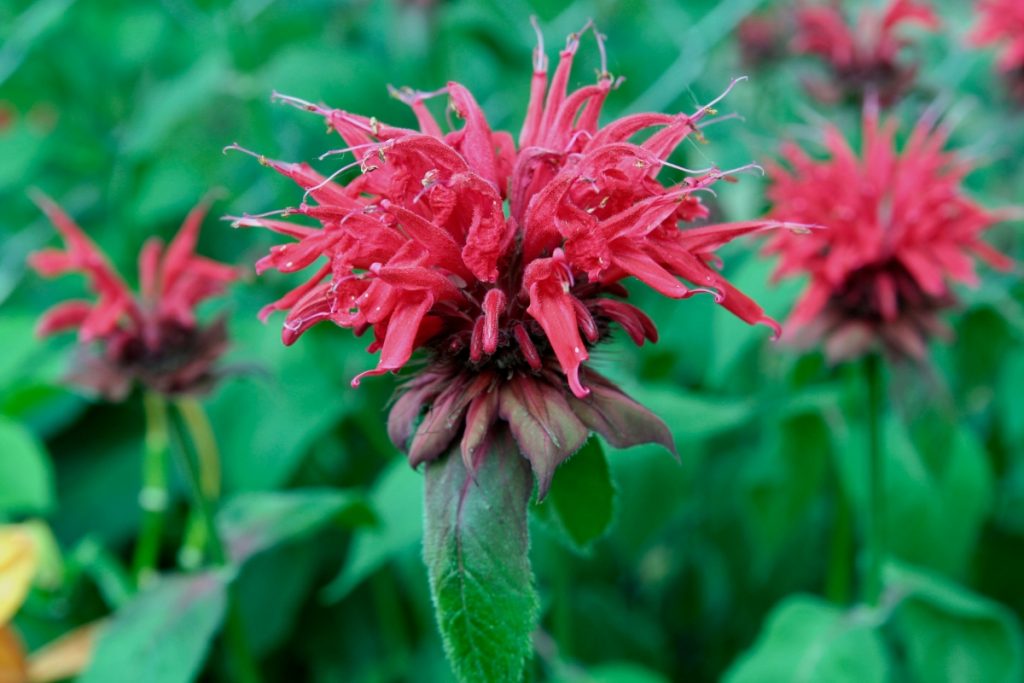
5. Bee Balm
Also called monarda, bee balm bursts with bushy flowers in summer. The shaggy tubular blooms in shades of red, pink, purple, and white draw swarms of hummingbirds, bees, and butterflies. Grow bee balm in mass plantings or spotlight it in perennial borders. ‘Jacob Klein’ is a mildew-resistant scarlet red cultivar that hummers love. For diverse blooms, try bee balm varieties ‘Raspberry Wine’ and ‘Snow White’.
Zones: 4-9
Height: 12-48 inches
Flower Color: red, pink, purple, white.
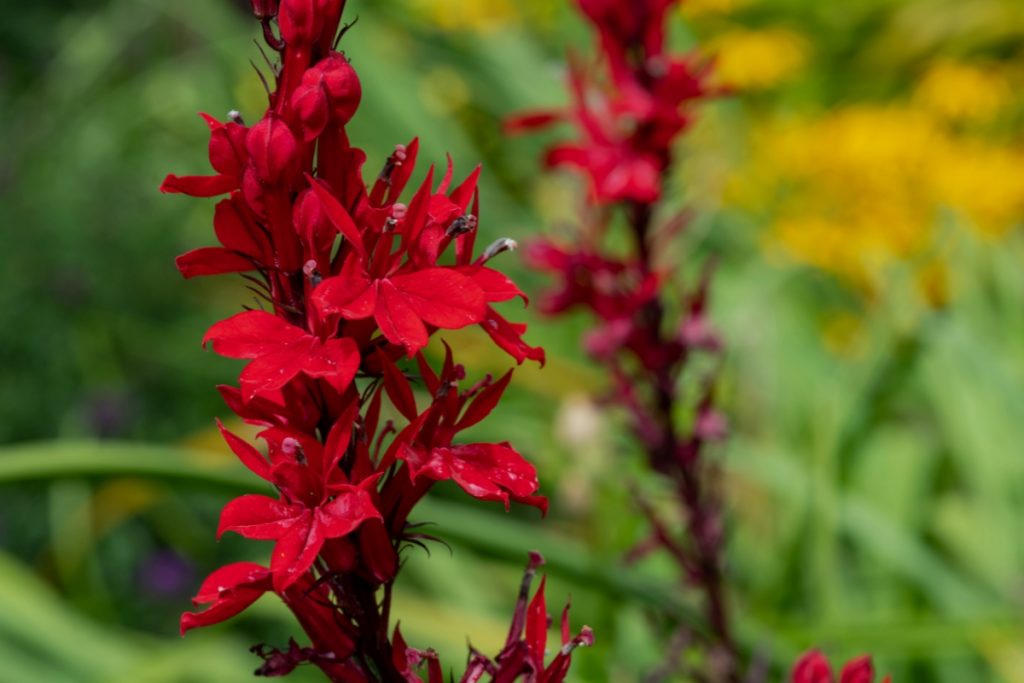
6. Cardinal Flower
Aptly named for its vivid red spikes of flowers, the cardinal flower is a hummingbird treasure. Its nectar contains a unique amino acid female hummers especially crave during nesting and migration seasons. For reliable blooms, provide rich, consistently moist soil and partial shade. Combine with blue lobelia and purple bee balm for a perfect colour scheme.
Zones: 3-9
Height: 24-48 inches
Flower Color: red.
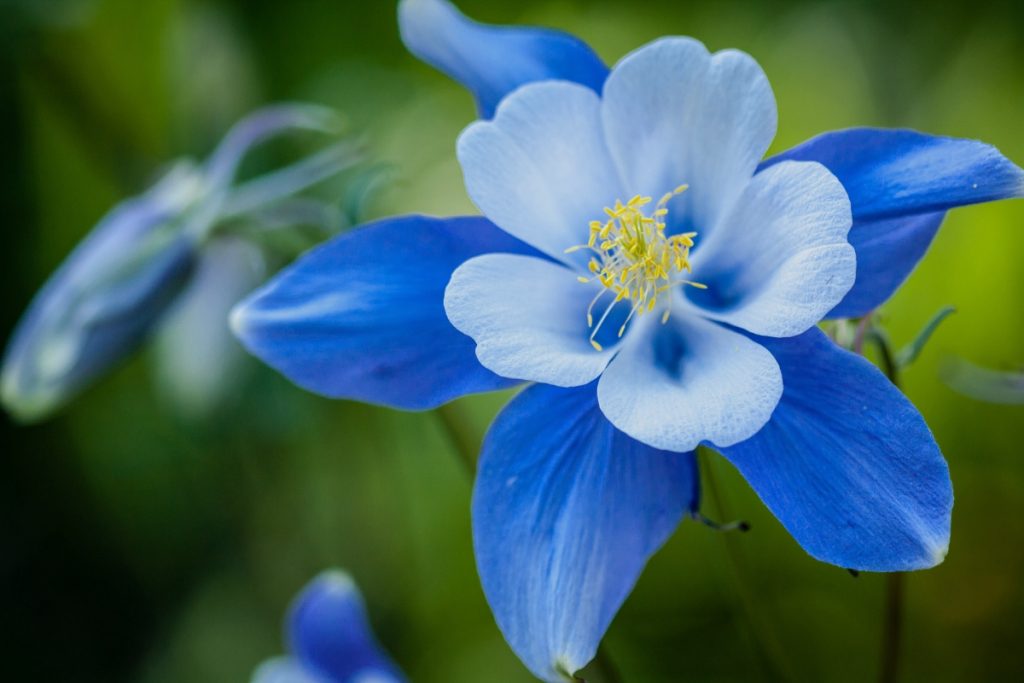
7. Columbine
Delicate yet hardy, columbine thrives in shade gardens or naturalized areas. The elegant flowers come in bicolour shades of red, yellow, pink, purple, and white. Short-spurred types offer easier nectar access. Columbines readily self-seed, providing years of effortless blooms. Attract hummingbirds by planting drifts of this sweet woodland native.
Zones: 3-9
Height: 12-36 inches
Flower Color: red, yellow, pink, purple, white.
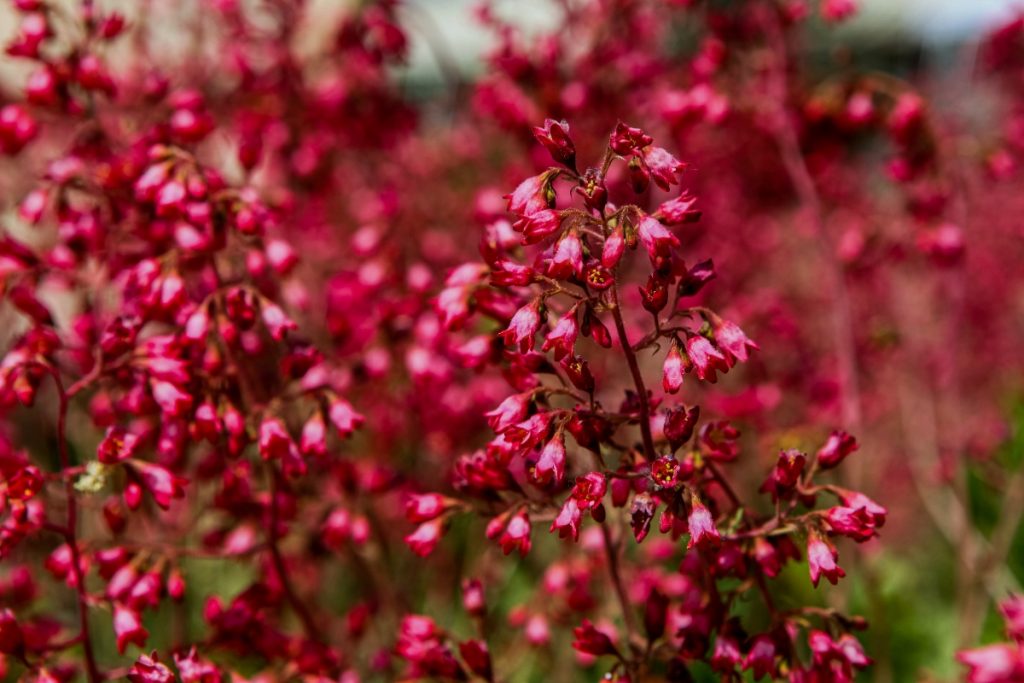
8. Coral Bells
Coral bells produce charming floppy spikes covered in tiny bell-shaped blossoms. Varieties in warm sunset colours like ‘Mardi Gras’ and ‘Caramel’ attract the most hummingbirds, though all flower colours get visits. Coral bells thrive in shade with rich, moist soil. Use them as striking groundcovers and in shade borders and woodland gardens.
Zones: 3-9
Height: 4-20 inches
Flower Color: pink, orange, yellow, red.
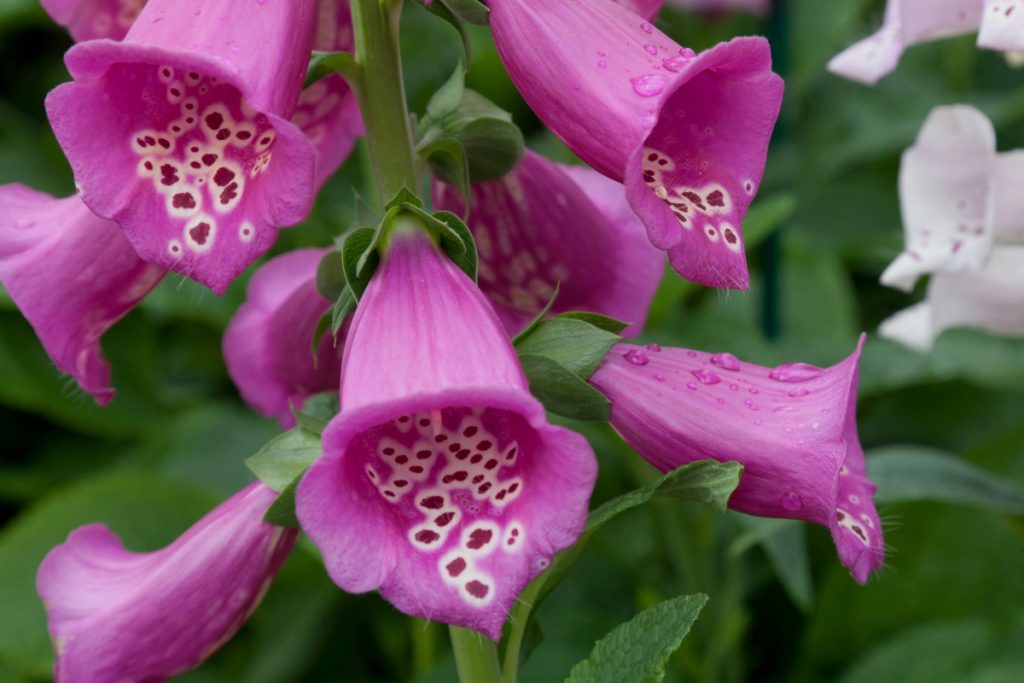
9. Foxglove
Majestic towering spires of foxglove flowers make a bold garden statement. Inside the speckled, tubular blooms is abundant nectar only hummingbirds can reach. Though foxgloves are technically biennial, they self-seed readily for perennial colour. Site foxgloves in partial shade gardens and woodland settings. Handle carefully as the plant contains toxic cardiac glycosides.
Zones: 5-9
Height: 3-5 ft
Flower Color: purple, pink, white, yellow.
Vines and Climbers
Hummingbirds dart energetically among the flowers of climbing vines, like pursuing tasty snacks. Plant vining plants on fences, arbours, and trellises to take advantage of vertical spaces in yards of all sizes. Vines also weave beautifully through borders and woodlands for added dimension.
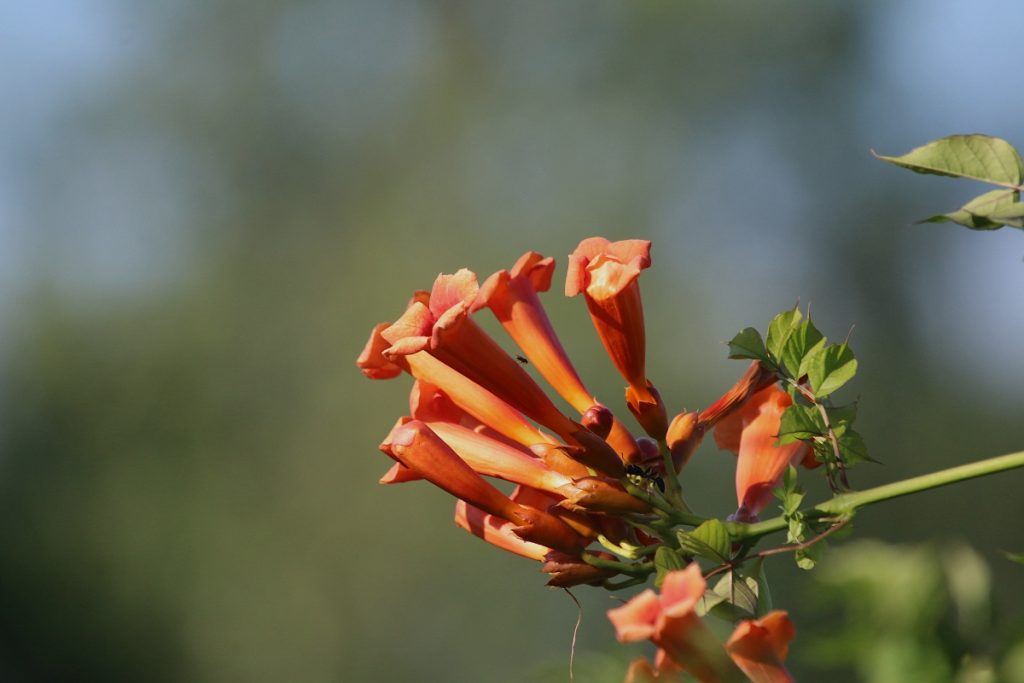
10. Trumpet Vine
As one of the most reliable native hummingbird plants, trumpet vine delivers streams of scarlet, orange, or yellow blooms atop woody vines. It latches firmly to structures with aerial rootlets and climbs 20 feet or more yearly. Prune annually to control spread. Combine with passionflower and native honeysuckle for nonstop food. Site carefully as trumpet vine can be aggressive.
Zones: 4-9
Height: 20-40 ft
Flower Color: red, orange, yellow.
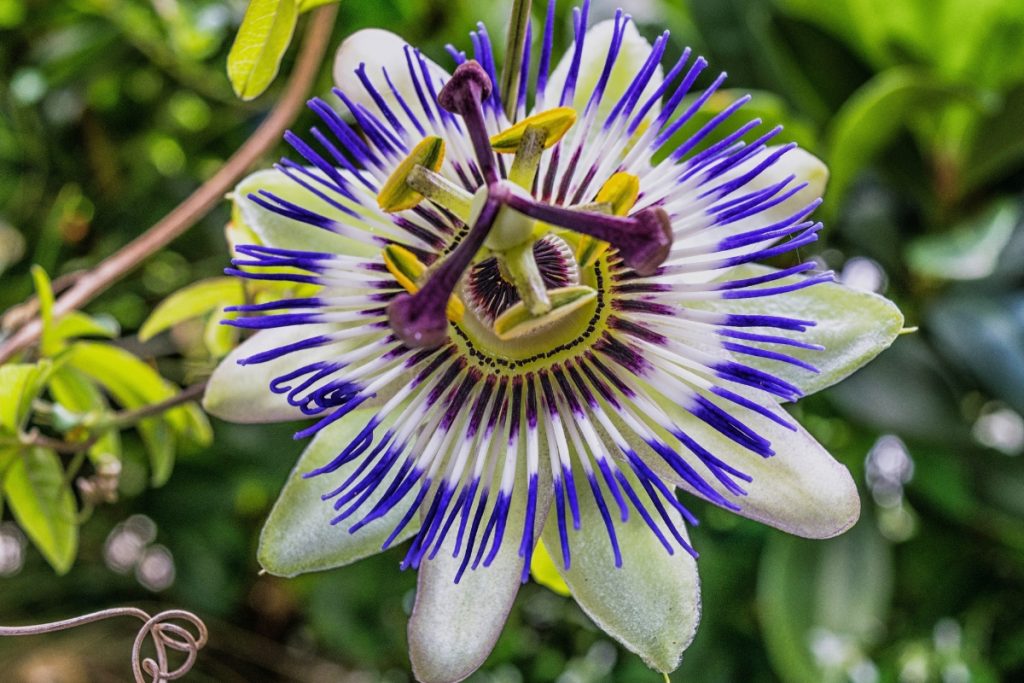
11. Passion Flower
Exotic looking passion flower features intricate blossoms with prominent stamens hummingbirds gather pollen from. The aptly named Maypop passion flower produces juicy fruit in late summer. Fast-growing vines spread widely across fences and arbours, producing food within the first year. Site passion flower carefully and prune yearly to keep it under control.
Zones: 5-9
Height: 10-20 ft
Flower Color: purple, white, pink, red.
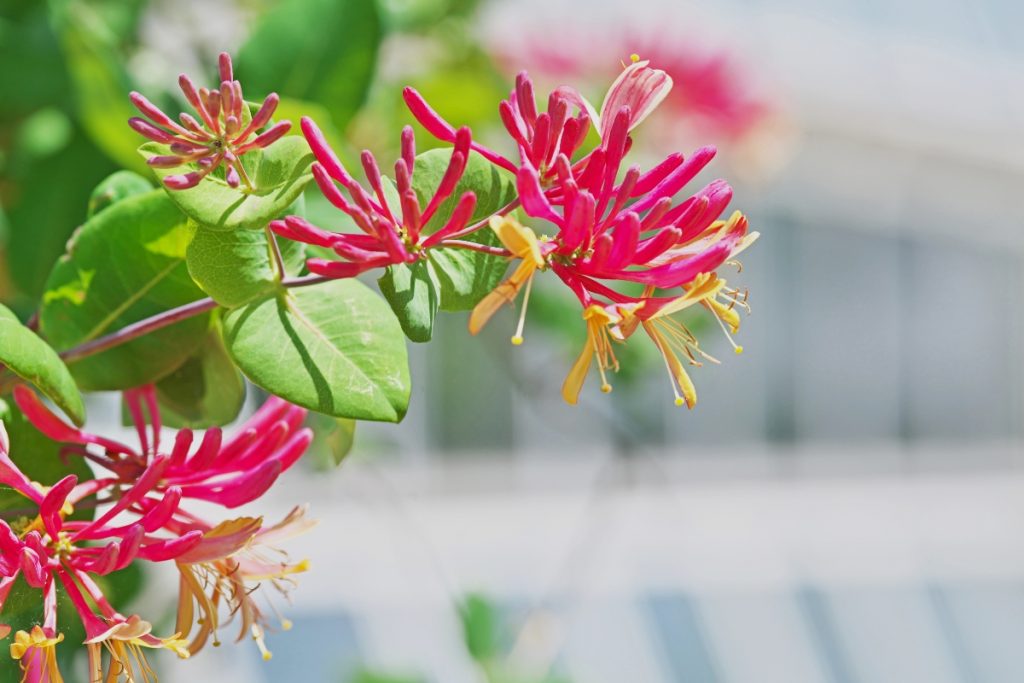
12. Native Honeysuckle
Sweetly fragrant native honeysuckle comes in both vining and bush forms. Tubular flowers in shades of red, orange, and white bloom from spring through fall. Prune frequently to encourage maximal flower production. Site carefully and avoid invasive Japanese honeysuckle, which chokes out beneficial native plants.
Zones: 4-11
Height: 10-20 ft
Flower Color: white, yellow, orange, red.

13. Cypress Vine:
A hummingbird’s favourite cypress vine produces hundreds of vibrant red trumpets amid lacy green foliage. Fast-growing annual vines climb 8 to 12 feet tall through trellises and arbours. Direct sow seeds each spring for quick colour. The ferny leaves offer a nice contrast to bold blooms. Site by porches, patios, and hummingbird feeders.
Zones: 9-11
Height: 6-12 ft
Flower Color: red, and white.
Shrubs and Small Trees
Flowering shrubs and trees offer shelter, plus food for hummingbirds nesting and resting in your yard. Plant a variety with staggered bloom times for year-round bright colour and sweet nectar supplies.
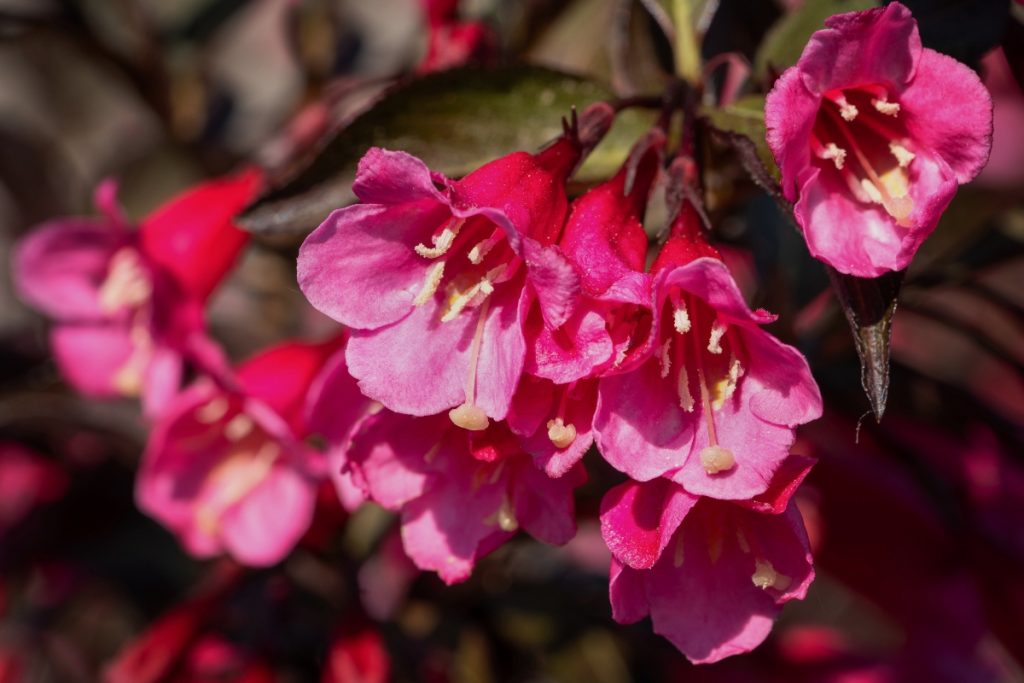
14. Weigela
Weigela builds the perfect arcing branches for hummingbirds to rest and nest in. Showy spring flowers come in shades from white to dark pink. New cultivars like ‘Spilled Wine’ offer deep red blooms. For best flower production and healthy growth, site weigela in full sun with good drainage and ample moisture.
Zones: 4-8
Height: 4-6 ft
Flower Color: pink, red, white.
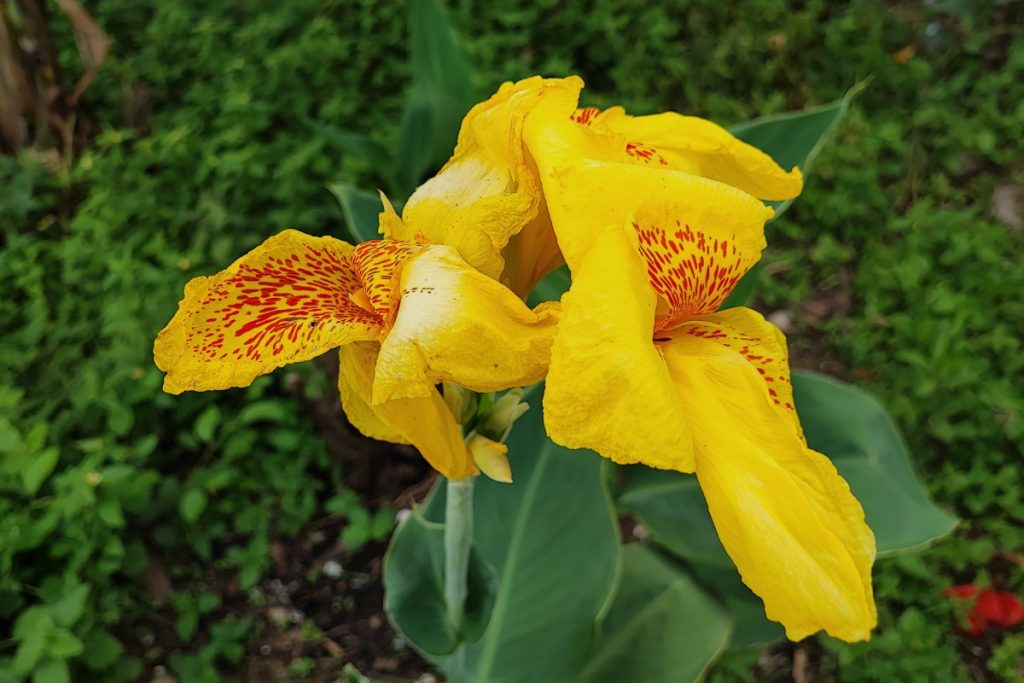
15. Canna Lily
With flamboyant tropical style, cannas pump out flowers in dazzling warm shades continuously through summer. Hummingbirds hover at the cups, gathering abundant nectar. Extend bloom season by pinching off spent flowers. Grow cannas as stunning border plants or tuck them into large containers. Dig and store the rhizomes each winter.
Zones: 7-11
Height: 3-6 ft
Flower Color: red, orange, yellow, pink.
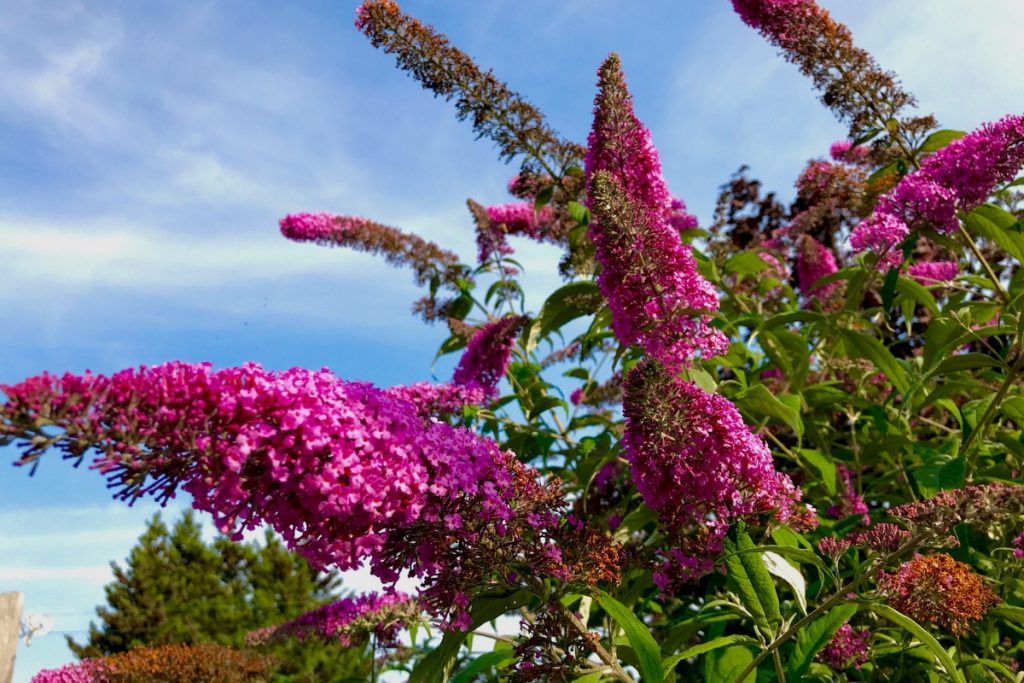
16. Butterfly Bush
As their name suggests, butterfly bushes invite clouds of hummingbirds and pollinators. Long tapering flower clusters called panicles come in shades from pale pink to rich magenta. Blooms appear on new wood, so prune annually in early spring for prolific flowering. Grow butterfly bushes as colourful hedges or focal point shrubs. Regular deadheading extends bloom time.
Zones: 5-9
Height: 6-15 ft
Flower Color: white, pink, purple, blue.
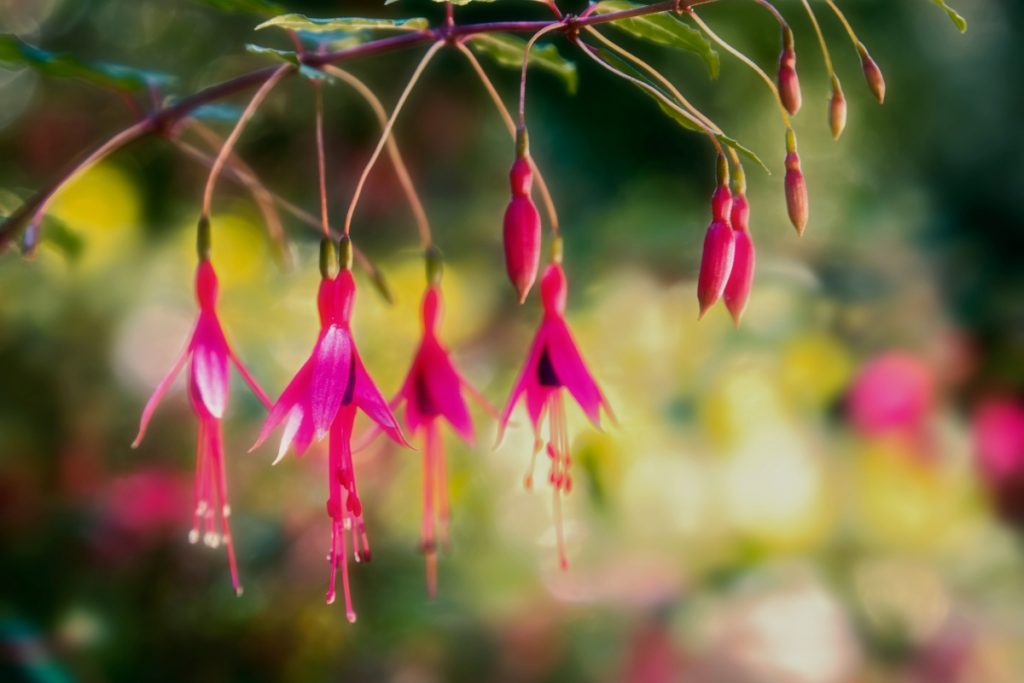
17. Fuschia-Flowering Gooseberry:
For brilliant red tubular flowers reminiscent of fuchsias, add fuschia-flowering gooseberry to the borders. Arching branches display the vibrant bells all summer long. The bush forms an airy 4-foot tall, 4-foot wide mound, ideally sited in the morning sun with afternoon shade. Fuschia gooseberry makes a beautiful flowering hedge or garden accent plant.
Zones: 4-8
Height: 3-4 ft
Flower Color: red.
Trees
Graceful flowering trees give hummingbirds lofty places to rest and nest high up out of predators’ reach. Trees also connect key habitat areas across ecosystems as hummingbirds travel great distances in their range.
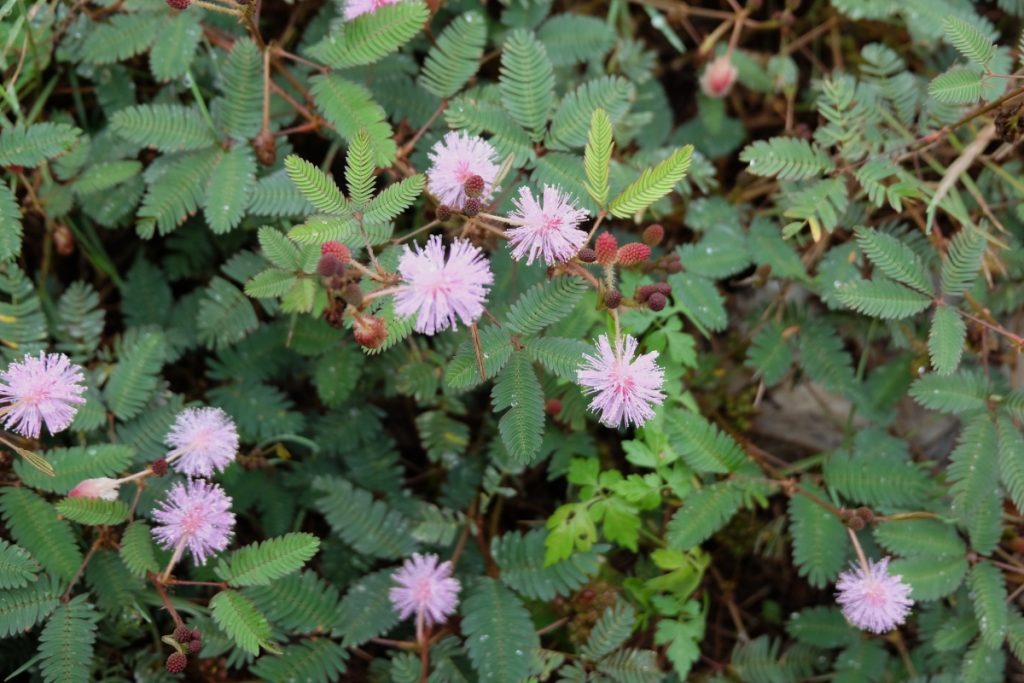
18. Mimosa
Few trees can compete with the tremendous beauty of mimosa in full bloom. Feathery pink powderpuff flowers cover every branch, perfuming the sultry summer air with a sweet, spicy scent. Hummingbirds swarm seeking nectar and insects attracted to the blossoms. The striking black bark and lacy foliage provide year-round interest after bloom time. Avoid planting invasive mimosa varieties, which spread aggressively by seed and shoots.
Zones: 6-9
Height: 20-40 ft
Flower Color: pink
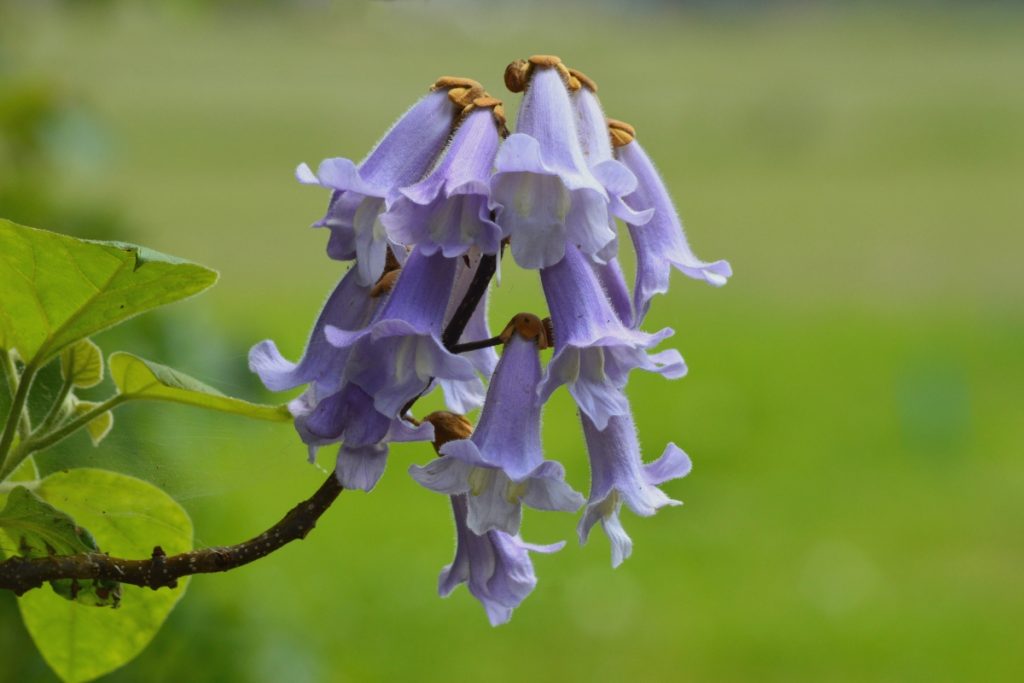
19. Royal Paulownia
Fast-growing royal paulownia bursts with huge clusters of showy violet flowers in spring before the leaves emerge. Hummingbirds probe the large tubular blooms for nectar for over a month. The heart-shaped leaves are yellow beautifully in fall. Use royal paulownia as a focal point specimen with its straight central trunk and tiered horizontal branching structure.
Zones: 5-9
Height: 40-60 ft
Flower Color: violet.
Native Plants
Native plants hold special importance for hummingbirds, having coevolved together over thousands of years. They are precisely adapted to provide the food, habitat, and migration cues hummingbirds rely on. Make native plants priority additions to your yard.

20. Butterfly Weed
As a critical monarch butterfly host plant and stellar nectar source, no native garden is complete without butterfly weed. Brilliant clustered orange blooms top upright 2-foot tall plants all summer. Utilize butterfly weed as a colourful dry meadow or prairie garden accent. Site in full sun with well-drained soil.
Zones: 3-10
Height: 12-36 inches
Flower Color: orange.
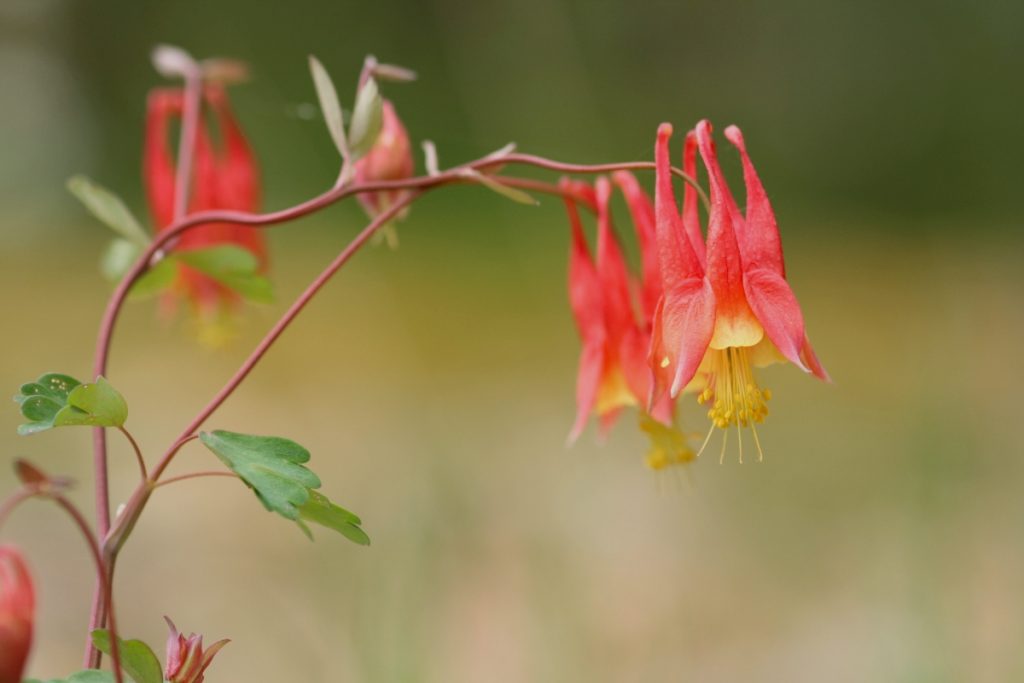
21. Wild Columbine
Common in mountain meadows and woodland edges, wild columbine thrives in shade gardens. The red-and-yellow blooms offer copious nectar. Columbines are readily self-sow for endless naturalized charm. Combine them with ferns, coral bells, and native azaleas for a lush woodland tapestry.
Zones: 3-9
Height: 12-36 inches
Flower Color: red and yellow.
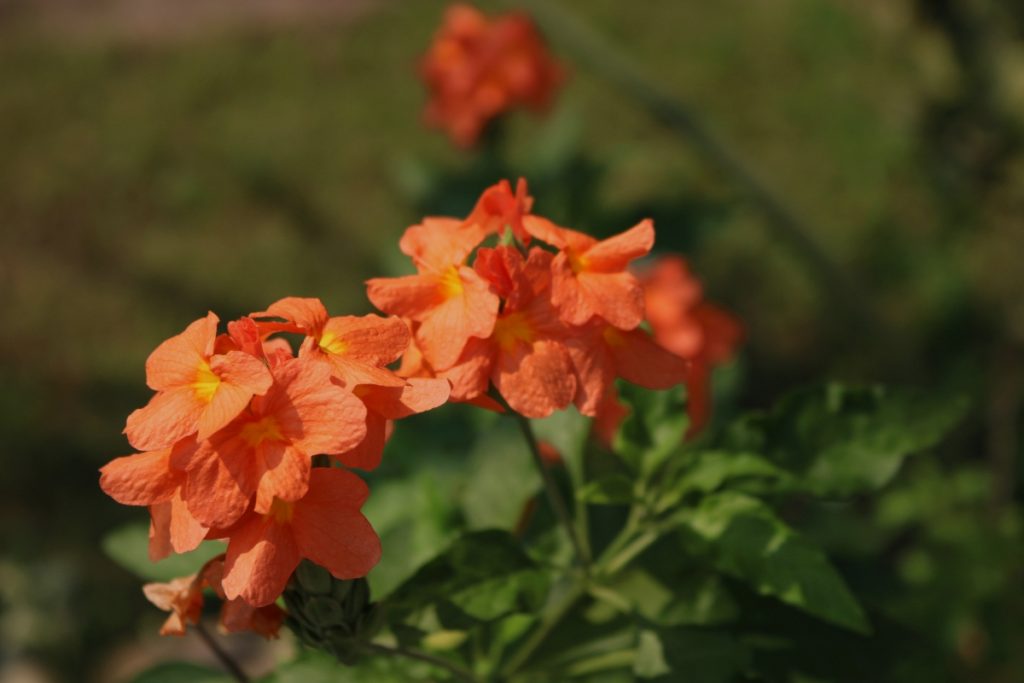
22. Firecracker Flower
As a prairie and meadow native, the firecracker flower pumps out tubular red blooms encircled with starburst yellow tips. The no-fuss plant thrives in hot, dry conditions. Its nectar and pollen sustain hummingbirds as well as native bees and butterflies. Use firecracker flowers in borders, rock gardens, and native habitat gardens.
Zones: 5-9
Height: 24-36 inches
Flower Color: red and yellow.
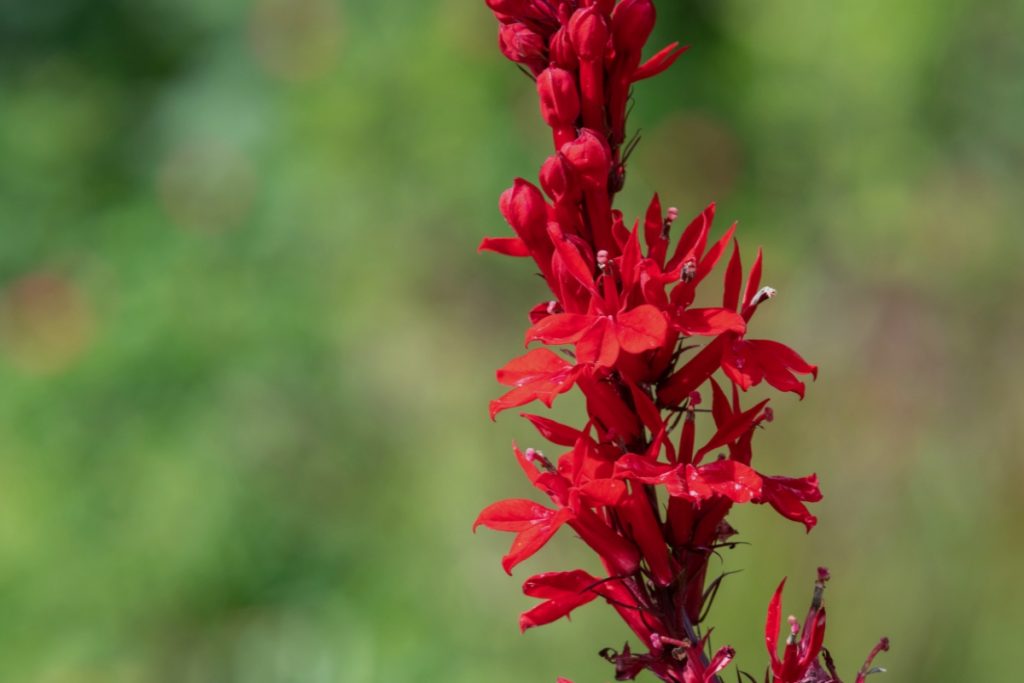
23. Cardinal Flower
Growing along stream banks and pond edges, brilliant cardinal flower lights up shady landscapes. Spikes bursting with bright red tubular blooms feed migrating ruby-throated hummingbird populations especially. Protect cardinal flowers from intense sun and provide consistently moist soil for best flowering and nectar production.
Zones: 3-9
Height: 24-48 inches
Flower Color: red.
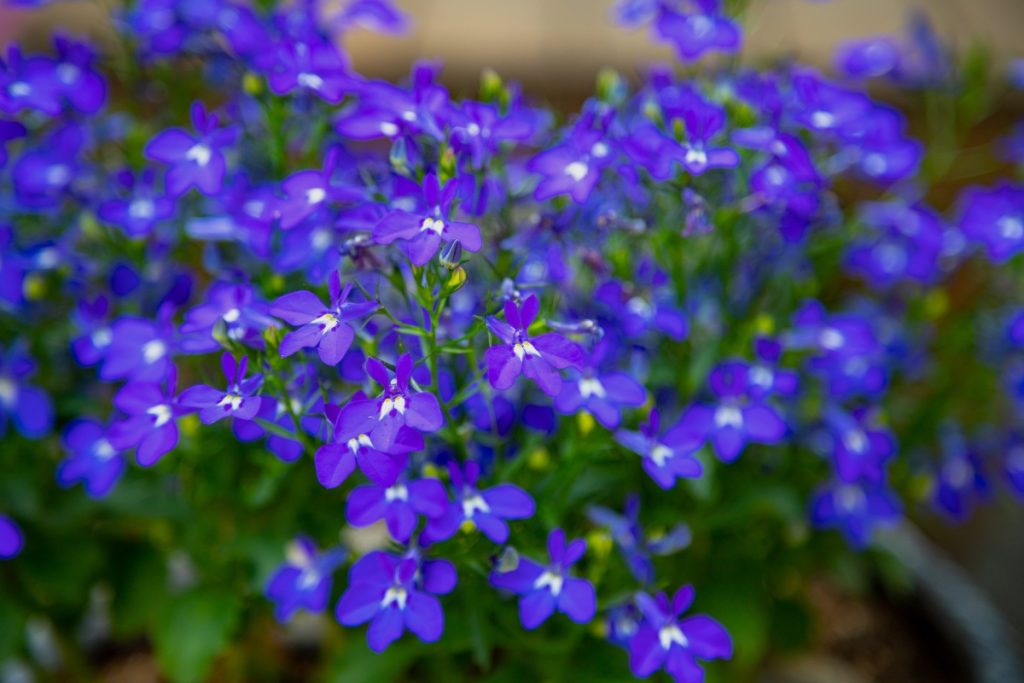
24. Lobelia
Dainty yet durable lobelia produces clouds of tiny blossoms adored by hummingbirds. Both scarlet cardinal flower and great blue lobelia clump appealingly along partly shaded garden edges, offering nectar-rich blooms. Allow some lobelia plants to self sow for thick drifts hummingbirds flock to all season.
Zones: 3-9
Height: 6-12 inches
Flower Color: blue, red.
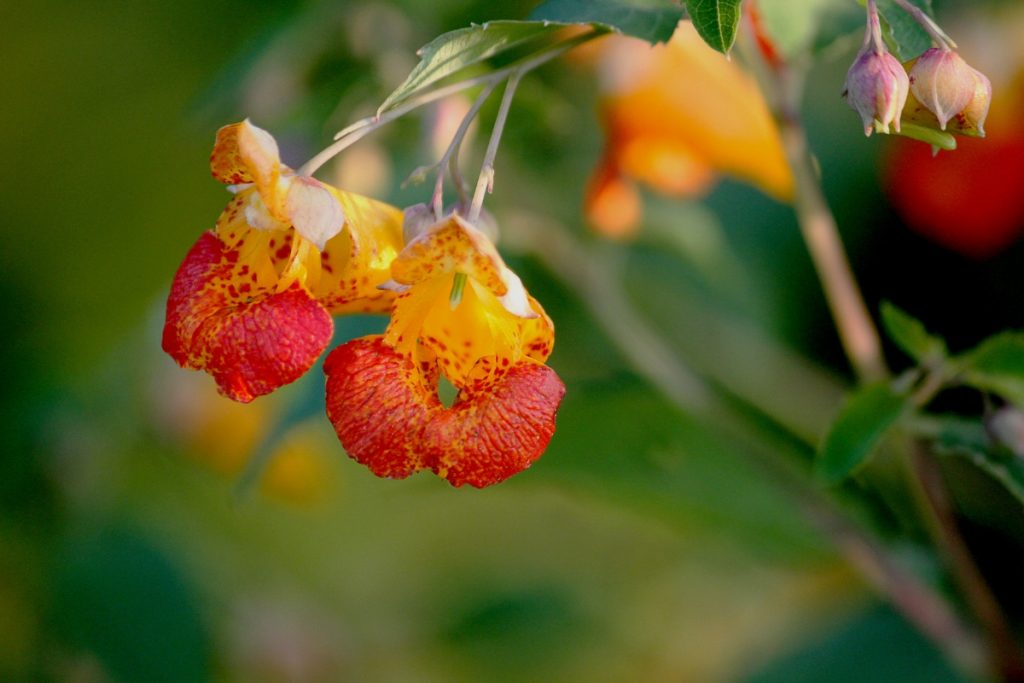
25. Jewelweed
Flourishing along shady stream banks, jewelweed offers a Mediterranean look but thrives in both sun and shade. The aptly named orange and yellow flowers resemble dangling jewels, drawing in hummingbirds all season long with their high nectar content. Interestingly, jewelweed sap soothes skin irritation from poison ivy, stinging nettle, and insect bites too.
Zones: 3-10
Height: 2-4 ft
Flower Color: orange, yellow.
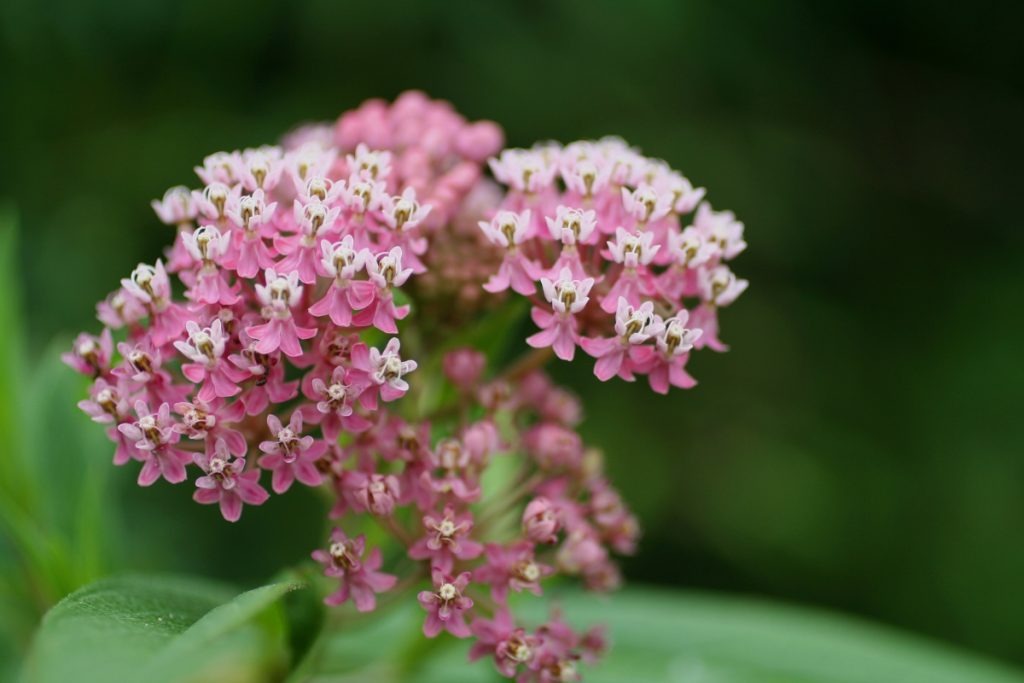
26. Milkweed
As the obligate host plant for monarch butterflies, common milkweed plays several critical ecological roles. Milkweed provides food and shelter to hummingbirds, too, with its spherical flower clusters and huge seed pods. Over a dozen native milkweed species occur across North America, each tailored to specific site conditions and native pollinators.
Zones: 3-10
Height: 2-4 ft
Flower Color: pink, white, purple.
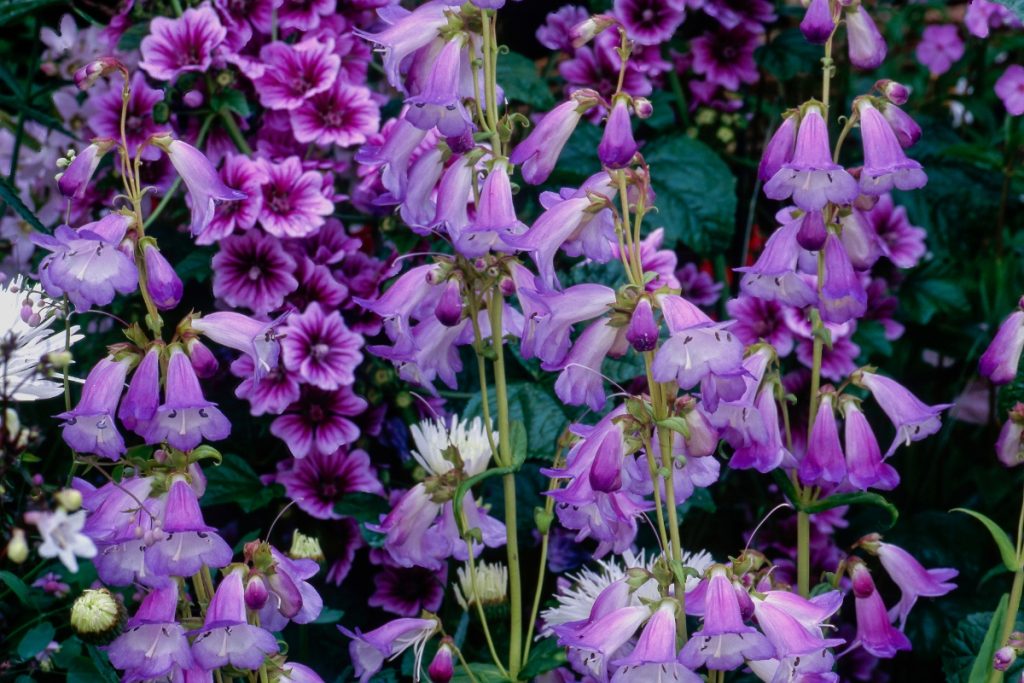
27. Penstemon
One of the largest perennial plant genera in North America, over 250 species of beardtongue (penstemon) live throughout the continent. These stalwart natives thrive from deserts to alpine meadows, offering tubular blooms beloved by hummingbirds. Easy penstemons for gardens include ‘Husker Red’, ‘Dark Towers’, and ‘Prairie Dusk’.
Zones: depends on variety
Height: 1-3 ft
Flower Color: pink, purple, red, white.
Plants that Attract Hummingbirds to Western States
Gardeners west of the Rocky Mountains can attract hummingbirds with these water-wise native plants suitable for arid climates.
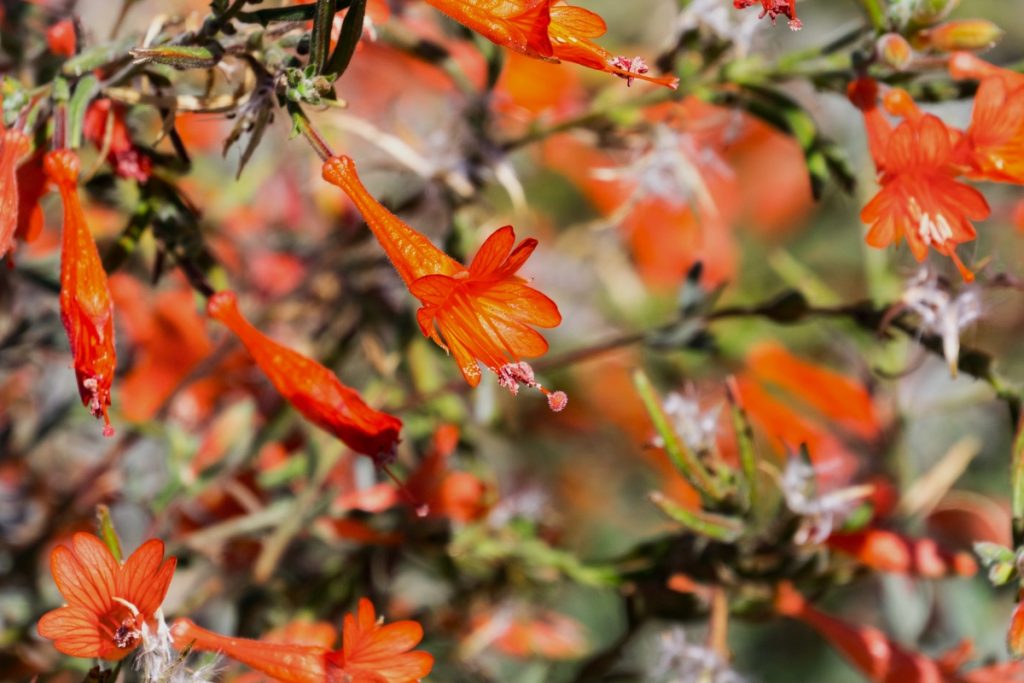
28. California Fuchsia
Even in the shade, California fuchsia pumps out vivid red trumpets nearly all year in mild winter regions. After flowering, the plant forms ruby red seed pods for winter interest. Use California fuchsia in borders, rock gardens, and cascading over walls where hummingbirds will flock to the bright blooms.
Zones: 8-10
Height: 18 inches – 5 ft
Flower Color: red.
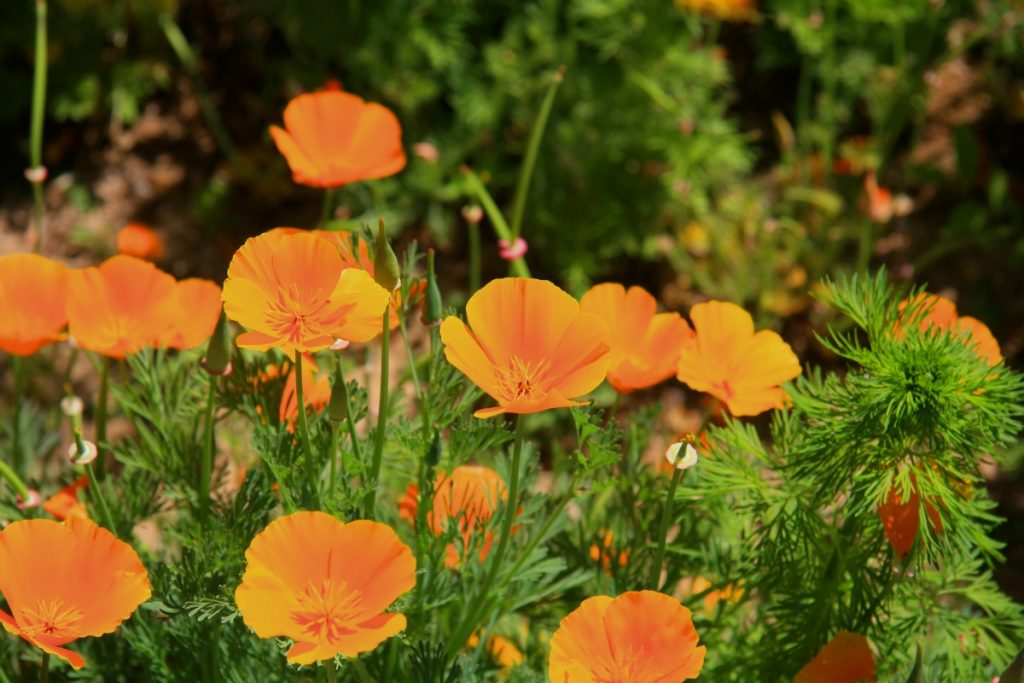
29. Orange Poppy Mallow
From sunny fields and desert washes, orange poppy mallow grows rapidly to form a neat, bushy mound. Saucer-shaped satiny flowers in brilliant shades of orange, red, and yellow bloom spring through fall. Give poppy mallow room to spread in rocky garden sites and meadow gardens.
Zones: 5-11
Height: 2 ft
Flower Color: orange, red, yellow.
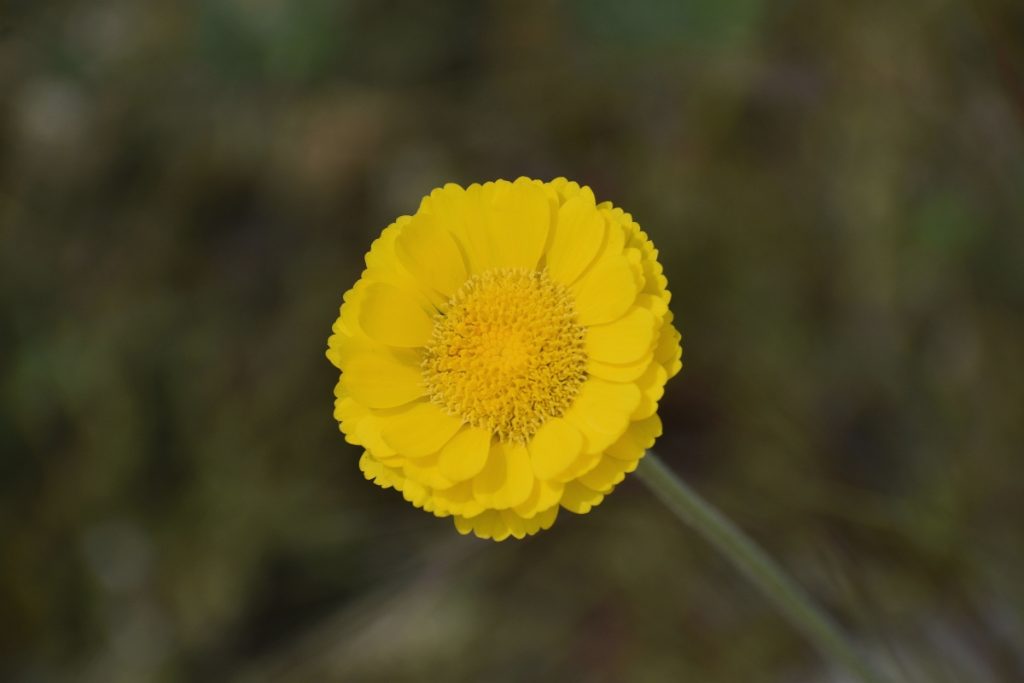
30. Desert Marigold
As a tidy clumping groundcover, desert marigold pumps out charming golden daisy-like blooms repeatedly. It thrives in lean, sandy soils with good drainage. Use desert marigolds in borders, rock gardens, or mass desert plantings along with penstemon and agave. Hummingbirds flock to the bright yellow colour.
Zones: 5-11
Height: 6-12 inches
Flower Color: yellow.
Plants That Attract Hummingbirds to Eastern States
In eastern gardens, include these native plants to draw hummingbirds and support sustainable local ecotypes.
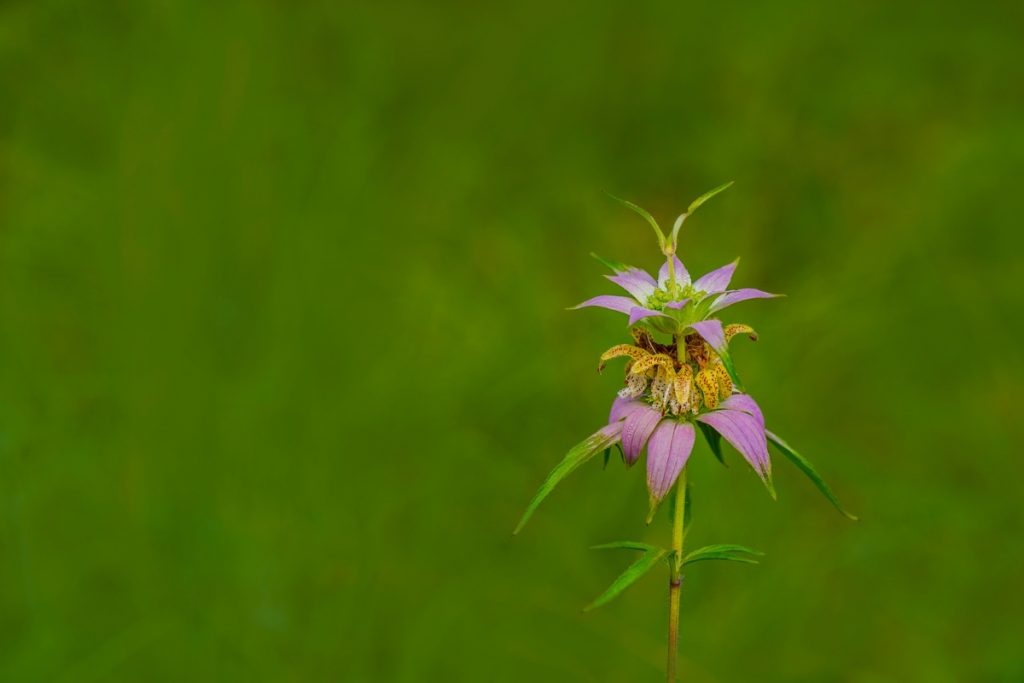
31. Spotted Bee Balm
With whorls of pinkish-purple tubular flowers, spotted bee balm decorates partly shaded forest edges and stream banks. Aromatic foliage releases a fresh citrus scent when crushed. Hummingbirds enjoy nectaring on the colourful blooms through summer into fall. Allow spotted bee balm to naturalize freely around woodland gardens.
Zones: 4-8
Height: 3 ft
Flower Color: pink, purple.
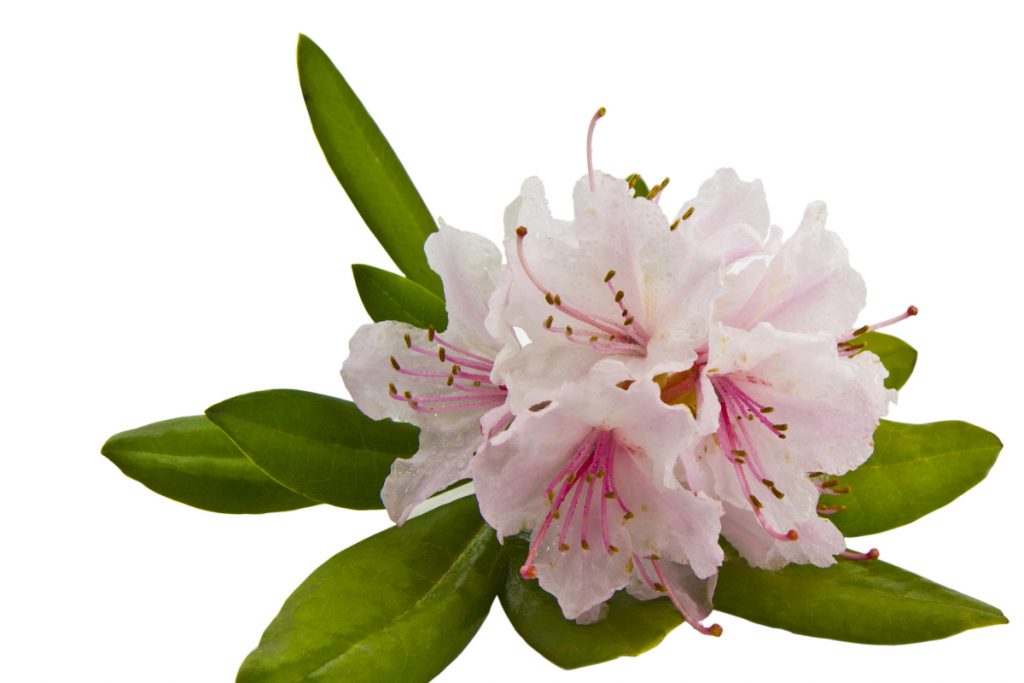
32. Rhododendron
Beloved for their spectacular blooms, Rhododendrons are a hummingbird favourite, particularly in the Eastern States. These evergreen shrubs produce large, vibrant flowers ranging from white to various shades of pink and purple.
Thriving in zones 4-8, Rhododendrons prefer well-drained, acidic soil and partial shade. Ensure they have enough space for air circulation to prevent disease. Their blooming period in the spring is a feast for the eyes and a banquet for hummingbirds, who are drawn to their trumpet-shaped flowers rich in nectar.
Zones: 4-8
Height: Varies (typically 2-12 ft, depending on the species)
Flower Color: White, pink, purple.
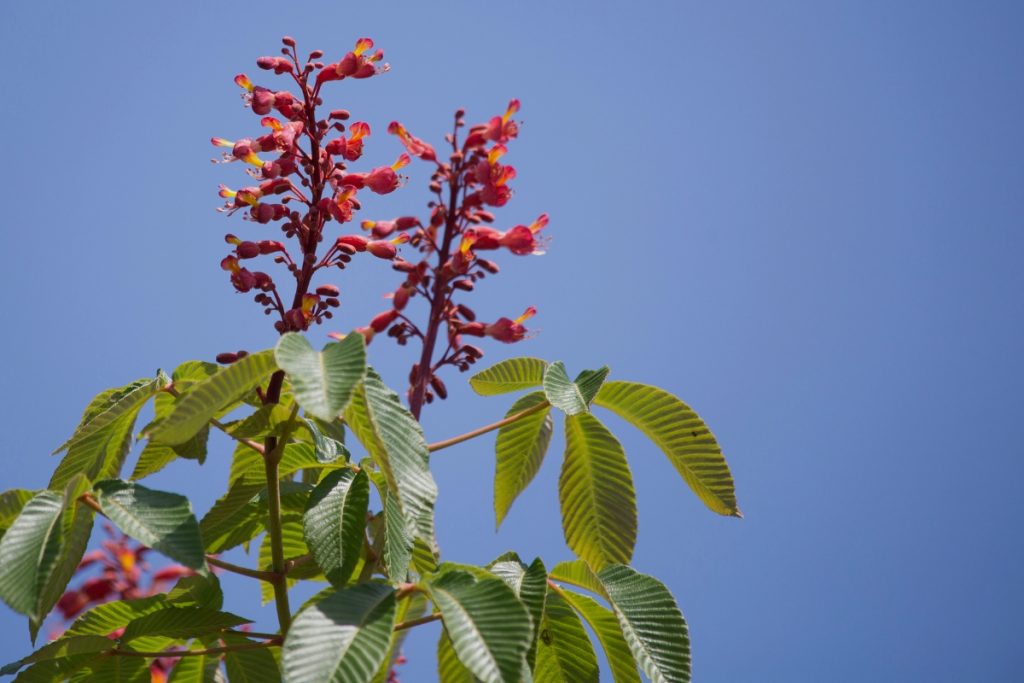
33. Red Buckeye
As a large shrub or small tree, red buckeye brings welcome shade and spring flowers to eastern yards. Long clusters of vibrant red tubular blooms cover the branches, attracting hummingbird migrants. Provide partial shade and moist, acidic soil. Use red buckeye as a focal point or plant groves for ample springtime interest.
Zones: 4-8
Height: 15-20 ft
Flower Color: red.
Planting for Year-Round Hummingbird Visitors
By planning monthly bloom times in your landscape, you can receive the gift of hummingbirds from early spring through late fall.
Include a mix of flowering trees, shrubs, bulbs, annuals, biennials, and perennials to ensure fresh nectar supplies all season long. If you notice production slowing from certain plants, fill gaps with strategically timed container plantings, too.
Here is a sample bloom calendar for year-round hummingbird appeal:
January – March
Flowering quince, fuschia-flowering gooseberry, magnolia, red buckeye
April – May Azalea, lilac, honeysuckle, coral bells, columbine
June – August
Bee balm, hibiscus, zinnia, foxglove, cypress vine, fuchsia
September – October
Canna lily, pineapple sage, snapdragon, passion flower, sage
November – December
Fall-blooming camellia, Cape honeysuckle, rosemary, fire spike.
Designing With Hummingbird Flowers
When planning your beds, borders, and containers, keep these design tips in mind:
Go for bold colours
Paint your beds with vibrant reds, oranges, fuchsias, and other hot, vivid tones that lure hummers from afar. Use bright blooms as focal points against dark green shrubs and evergreen hedges.
Vary heights and forms.
Include a range of plants from dramatic vertical spikes to airy cloud-like shrubs and ground-hugging vines. Diverse heights and textures give hummingbirds varied landing and nesting sites.
Site tubular flowers in clusters
Hummingbirds conserve precious energy by visiting dense clusters of tubular flowers which offer abundant nectar conveniently located. Arrange hummingbird favourites like cardinal flower, bee balm, and pineapple sage in drifts and swaths for high colour impact and ease of feeding.
Provide places to perch.
Hummingbirds often pause to rest in the middle of frenzied feeding sessions. Position plants with strong stems and branches nearby blooming plants so hummers can reload and conserve their energy.
Include native plants
Support healthy local hummingbird populations by providing the native plants they’ve adapted to and rely on through generations. Native species like milkweed also host caterpillars hummingbirds feed to their young.
Supplement with feeders
Installing a few hummingbird feeders will train birds to visit your garden since they’ll associate your yard with dependable food sources.
Fill feeders with a basic sugar water solution of one part white sugar to four parts water. Change the solution every two days to prevent fermentation and bacteria.
Thoroughly clean feeders with hot water and vinegar every week. Feeders entice hummingbirds to stick around and explore other food sources you provide in nearby plantings.
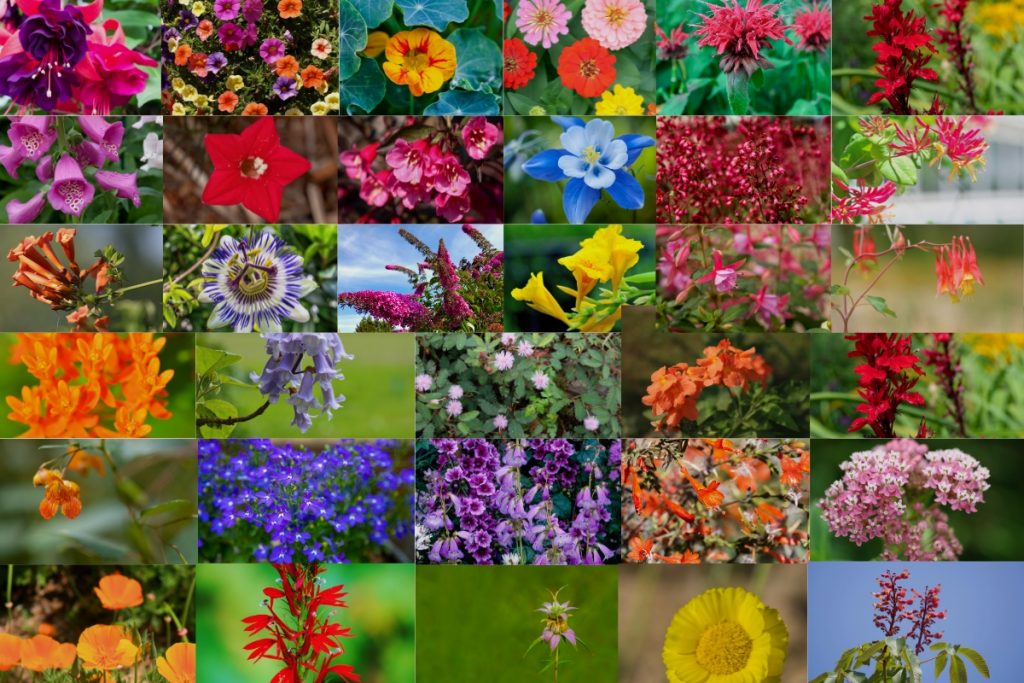
Top Hummingbird Flowers
The following plants top the list when it comes to reliable, rewarding flowers that hummingbirds flock to. Prioritize including several of these beauties in your landscape for dependable action.
Annuals: Nasturtium, fuchsia, zinnia
Perennials: Bee balm, pineapple sage, foxglove
Vines: Trumpet vine, native honeysuckle
Shrubs: Butterfly bush, weigela
Trees:
Royal paulownia, mimosa
Natives: Butterfly weed, columbine, lobelia
Conclusion
Beyond the wonder of watching a glittering hummingbird hover at an exquisite flower is the satisfaction of providing essential habitat for these miraculous migrant species.
By planting a variety of nectar-rich annuals, perennials, vines, shrubs, trees, and native plants, you support stable hummingbird populations thriving right in your own backyard.
Soon, these lovely tiny birds will return the favour by pollinating your other flowers, fruit trees, and vegetables while entertaining you all season long.
As always, thanks for reading. Let me know in the comments if you have any other questions you’d want me to answer or explain further.
Until next time, happy bird-watching!
Frequently Asked Questions (FAQs) – 33 Top Plants That Attract Hummingbirds
Q: What Specific Hummingbird Species Are Attracted to Fuchsia Flowers?
A: Fuchsia flowers are known to attract various hummingbird species, including the Ruby-throated Hummingbird, Anna’s Hummingbird, and the Black-chinned Hummingbird. These species are particularly drawn to the bright colours and tubular shape of Fuchsia flowers, which provide an excellent source of nectar.
Q: Which Gardening Zones Are Ideal for Growing Cardinal Flowers to Attract Hummingbirds?
A: Cardinal Flowers thrive in USDA hardiness zones 3-9. They are well-suited for moist, well-drained soils and partial shade, making them an excellent choice for gardeners looking to attract hummingbirds in these zones.
Q: How Do Hummingbird-Friendly Gardens Contribute to Pollination and Biodiversity?
A: Hummingbird-friendly gardens contribute to pollination by providing a habitat for hummingbirds, which are important pollinators for many native plants. This enhances local biodiversity by supporting a range of plant and animal species within the ecosystem.
Q: Can You Provide Specific Gardening Tips for Bee Balm to Attract Hummingbirds?
A: For optimal growth of Bee Balm, plant it in full sun to partial shade in well-drained soil. It’s a hardy perennial that responds well to division every few years. Regular deadheading encourages more blooms, which in turn attract more hummingbirds.
Q: What Are the Best Practices for Seasonal Planting and Care of Salvia to Attract Hummingbirds?
A: Salvia should be planted in late spring after the threat of frost has passed. It thrives in full sun and well-drained soil. Regular watering and pruning after the first bloom can encourage a second bloom period, extending its attractiveness to hummingbirds.
Q: What Are Effective Companion Plants for Trumpet Vine in a Hummingbird Garden?
A: Great companion plants for Trumpet Vine in a hummingbird garden include Catmint, Coneflowers, and Black-eyed Susans. These plants complement the vine’s growth habit and blooming time, creating a diverse habitat for hummingbirds.
Q: How Can I Manage Pests and Diseases in My Hummingbird Garden Without Harming the Birds?
A: To manage pests and diseases in a hummingbird garden, opt for organic solutions like neem oil, insecticidal soaps, or introducing beneficial insects. Avoid chemical pesticides, which can be harmful to hummingbirds and other wildlife.
Q: What Additional Features Can I Add to My Garden to Make It More Bird-Friendly?
A: Beyond flowering plants, adding features like a water source, such as a bird bath or fountain, and providing nesting sites or birdhouses can make your garden more bird-friendly. Also, preserving natural shelter like shrubs and trees offers resting and hiding spots for birds.
Q: How Does Planting Milkweed Benefit Hummingbirds and Monarch Butterflies?
A: Planting Milkweed benefits hummingbirds by providing them with a nectar source. It’s also crucial for Monarch butterflies, as it’s the only plant where they lay eggs and the caterpillars feed, thus supporting these species’ conservation.
Q: What Are the Best Practices for Organic Gardening to Attract Hummingbirds?
A: Best practices for organic gardening to attract hummingbirds include using organic fertilizers, composting, mulching, and practising integrated pest management. These methods ensure a healthy garden ecosystem that is safe and attractive for hummingbirds.
Q: How Can I Ensure a Range of Flowering Times in My Garden to Attract Hummingbirds?
A: To ensure a range of flowering times, plant a variety of species that bloom at different times throughout the year. This can include early spring bulbs, summer-blooming perennials like Bee Balm and Salvia, and late-flowering plants like Pineapple Sage.
Q: Are There Specific Native Plants I Should Include in My Hummingbird Garden for the Eastern States?
A: In the Eastern States, native plants like the Spotted Bee Balm, Cardinal Flower, and Red Buckeye are excellent for attracting hummingbirds. They are well-adapted to the local climate and provide nectar throughout various seasons.
Q: What Role Do Trees Like Royal Paulownia and Mimosa Play in Attracting Hummingbirds?
A: Trees like Royal Paulownia and Mimosa play a vital role in attracting hummingbirds by providing both nectar through their flowers and safe resting and nesting sites in their branches, thus creating a more diverse and welcoming habitat.
Q: How Can I Use Feeders to Supplement My Garden’s Attraction to Hummingbirds?
A: To supplement your garden’s attraction, install hummingbird feeders filled with a sugar water solution (1 part sugar to 4 parts water). Place them near flowering plants but in a clear, open area to attract hummingbirds and encourage them to explore other nectar sources in your garden. Remember to clean the feeders regularly to prevent mold and bacteria buildup.
Q: What Are Effective Strategies for Water Conservation in Hummingbird Gardens in Arid Regions?
A: In arid regions, water conservation strategies for hummingbird gardens include using drought-tolerant plants like California Fuchsia and Desert Marigold, implementing drip irrigation systems for efficient watering, and mulching to retain soil moisture. These practices ensure a vibrant garden that attracts hummingbirds without excessive water usage.
Q: How Can I Incorporate Year-Round Blooming Plants in My Hummingbird Garden for Continuous Attraction?
A: To maintain year-round attraction in your hummingbird garden, include a mix of plants that bloom in different seasons. Start with early bloomers like Flowering Quince, transition to summer favourites like Zinnias and Bee Balm, and finish with late bloomers like Pineapple Sage and Snapdragon. This ensures a continuous supply of nectar throughout the year.
Useful Links:
Related Posts to Read:
- Do Hummingbirds Beaks Open When Feeding?
- The Mysteries of Hummingbird Flight.
- 6 Fascinating Facts About Hummingbird Sizes.
- Ruby-Throated Hummingbird Migration Map.
- Where Do Hummingbirds Go When It Rains?
- How Much Does A Hummingbird Eat Per Day?
References:
- About Hummingbird (Link).
- Greenewalt, C. H. (1960). Hummingbirds. New York: Doubleday. Google Scholar.
- Carey C. The impacts of climate change on the annual cycles of birds. Philos Trans R Soc Lond B Biol Sci. 2009 Nov 27; 364(1534):3321-30. doi: 10.1098/rstb.2009.0182. PMID: 19833644; PMCID: PMC2781852.
- Rico-Guevara A, Rubega MA, Hurme KJ, Dudley R. Shifting Paradigms in the Mechanics of Nectar Extraction and Hummingbird Bill Morphology. Integr Org Biol. 2019 Jan 2;1(1):oby006. doi: 10.1093/iob/oby006. PMID: 33791513; PMCID: PMC7671138.
- Tyrrell LP, Goller B, Moore BA, Altshuler DL, Fernández-Juricic E. The Orientation of Visual Space from the Perspective of Hummingbirds. Front Neurosci. 2018 Jan 30;12:16. doi: 10.3389/fnins.2018.00016. PMID: 29440985; PMCID: PMC5797624.
- Hummingbirds Sighting (Journey North Map).
- About Hummingbird’s Characteristics.
